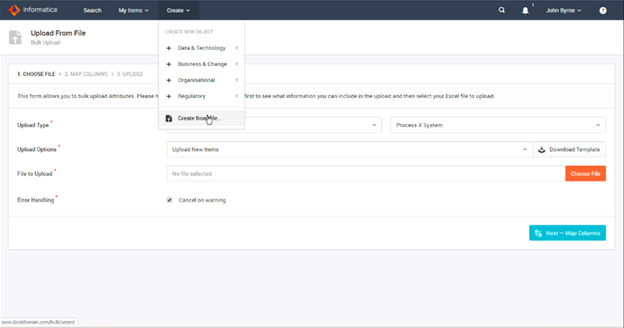- What are the advantages of Informatica over other ETL tools? …
- What are the main components of Informatica? …
- What can Informatica be used for in an organization? …
- What is an enterprise data warehouse? …
- Describe an Informatica workflow. …
- What is the domain?
Data Governance is a practice involving people, processes, and technology to effectively manage various risks involved in the data lifecycle (i.e., security, privacy, regulatory compliance, quality, reliability, etc.). The main objective is to establish the organization, principles, standards, and repeatable processes to collectively steward and manage company data. Having knowledge about the data an organization owns, different dependencies, and stakeholders involved in data management is important for effective data governance.
As a four-time leader in Gartner’s Magic Quadrant, Informatica Axon is a popular data governance tool that facilitates a collaborative environment to collect different data objects (metadata collection), link them, and control access to the metadata. This “knowledge repository” immensely helps data governance, as it provides information about what needs to be governed and how different assets in the organization are linked with an integrated view.
Default facets visible in Axon without being added to the search view are System, Data Sets, Attributes, Glossary, Data Quality, and People:
Here is a screenshot of the default facets. We can add additional facets by clicking on the “+” button next to the “People” facet. Additional facet selection will have to be done every time we log in to the Axon application.
To create an object, click on the “Create” link at the top of the screen and select the corresponding object from the menu, as shown in the below picture. Here in this picture, a new interface object is created. And, you can observe that the prerequisite object for an interface is a “System.”
Frequently Asked Questions by Axon, EDC, IDQ and DPM Customers
Interviews for Top Jobs at Axon
Firmware Engineer Interview
I applied online. I interviewed at Axon
Interview
THIS COMPANY DOESN’T HIRE BLACKS/INDIANS/ASIANS (ONLY WHITE FOLKS). IF YOU ARE GETTING INTERVIEWS, BEWARE AS IT IS A WASTE OF TIME. 1. Email with Recruiter 2. Interview Call with Recruiter 3. Interview call with hiring manager4. 10 days gap as recruiters finding it hard to setup a whole day interview5. Finally a date has setup 6. Interview day (no coderpad has been provided) 7. After interview is done, another 15 days gap to get the outcome.
Senior Site Reliability Engineer Interview
I interviewed at Axon in Oct 2022
Interview
Challenging, long interview process with 8+ hour commitment. No feedback given on decision to not hire. Don’t waste your time. Interview process: meet with hiring manager, code screening, tech architecture take home assignment and discussion interview, values interview and cultural fit interview .
- Design the evidence upload product
SDR Interview
I interviewed at Axon
Interview
2 Interviews (one with recruiter, one with managers).First interview was great! 2nd interview, super unreceptive.. I tried to control the interview but I was getting nothing out of the guy so I felt there was a disadvantage from the start.
- What is your Previous Sales Experience?
What do you understand by the term Worklet? Give the different available options in it/
Ans: Worklet refers to the group of workflow tasks that are accumulated in the set in a classified and organized format. The following are the different options available.
Creating Objects in the Right Order
The objects in Axon need to be created in sequential order. For example, a Dataset cannot be created until the System and the glossary item that describes it has been created. So, every object has a dependency on other parent objects to be created. Here is the sequential order of objects.
Objects in Axon can be created manually using the “Create” link on top of the Axon view and then selecting the appropriate object from the menu options, as discussed earlier. Once an object is created and saved, additional tabs become available to establish relationships between other objects with the current object.
There is another option to create objects in Axon using the “Bulk Upload.” This facilitates bulk data upload using a CSV file format with pre-existing templates for each object or to create relationships between the objects.
Bulk upload can be done by selecting the “Create” link and clicking the menu option “Create from file.” By selecting the “upload type,” it can be one of the options of “Object,” “Relationships,” or “Roles.” Then, specify actual Object/Relationship/Role, define the upload options by New/Existing, and click “Next-Map Columns.” In the next screen, the mappings are properly mapped and then click “Upload.” The status bar will show the status of completion and when the upload is successful. Any data errors related to the file upload can be fixed, and the file can be uploaded again.

You can also download the template using the “Download Template” option. Here is a screenshot of the template for System objects.

The columns in red are required, and the rest of the columns are optional. The file cannot be uploaded if data is missing from the required columns.
What do you mean by Enterprise Data Warehousing?
When the organization data is created at a single point of access it is called as enterprise data warehousing. Data can be provided with a global view to the server via a single source store. One can do periodic analysis on that same source. It gives better results but however the time required is high.
FAQ
What is Informatica Axon used for?
What is EDC and Axon?
What is difference between Informatica Axon and EDC?
How do you integrate Axon and EDC?
